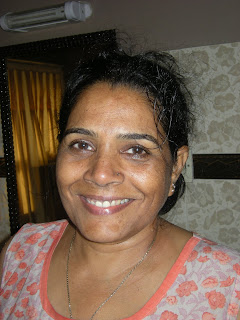.JPG)
The train went through Kerala, the state just to the west of Tamil Nadu. Here's beautiful, tropical Kerala from the train.
Kanyakumari is "located at the southernmost tip of the Indian Peninsula, it is also know by its former name Cape Comorin. Kanyakumari takes its name from the Kumari Amman or Kanyakumari Temple, situated in the town, on the sea-shore, the very confluence of the three water-bodies - Bay of Bengal, Indian Ocean and the Arabian Sea." from Wikipedia http://en.wikipedia.org/wiki/Kanyakumari

Swami Vivekananda (Bengali: স্বামী বিবেকানন্দ, Shami Bibekānondo; Hindi: स्वामी विवेकानन्द, Svāmi Vivekānanda) (January 12, 1863–July 4, 1902), born Narendranath Dutta[2] is the chief disciple of the 19th century mystic Sri Ramakrishna Paramahamsa and the founder of Ramakrishna Mission.[3] He is considered a key figure in the introduction of Vedanta and Yoga in Europe and America[3] and is also credited with raising interfaith awareness, bringing Hinduism to the status of a world religion during the end of the 19th century.[4] Vivekananda is considered to be a major force in the revival of Hinduism in modern India.[5] He is best known for his inspiring speech beginning with "sisters and brothers of America",[6][7] through which he introduced Hinduism at the Parliament of the World's Religions at Chicago in 1893.[2] fromWikipedia http://en.wikipedia.org/wiki/Vivekananda

Also from our balcony we could see the memorial for Tamil poet Thiruvalluvar.
Thiruvalluvar (Tamil: திருவள்ளுவர்) was a celebrated Tamil poet who wrote the Thirukkural, a work on ethics in Tamil literature. The time period of Thiruvalluvar's existence has been based on mostly linguistic evidences rather than archeological evidences since none such has been determined. His period has been estimated to be between 200 BC and 10 BC. from Wikipedia http://en.wikipedia.org/wiki/Tiruvalluvar (In early blog posts we mentioned Thirvalluvar since another memorial to him was across the street from our guest house in Chennai.)
 Soon after arriving in Kanyakumari, we took a ferry to the island where the Vivekananda memorial stands.
Soon after arriving in Kanyakumari, we took a ferry to the island where the Vivekananda memorial stands. Vivekananda memorial
Vivekananda memorial.JPG) Vivekananda meditation center
Vivekananda meditation center From the temple on shore (Krishna and Carolyn)
From the temple on shore (Krishna and Carolyn) The next morning, everyone waited for the sun to rise. It was a rainy, windy day, so no ferries to the island memorials. We were glad we went when we arrived.
The next morning, everyone waited for the sun to rise. It was a rainy, windy day, so no ferries to the island memorials. We were glad we went when we arrived. Kanyakumari temple
Kanyakumari temple.JPG) From Kanyakamari temple
From Kanyakamari temple A wet Krishna in/by the sea(s)
A wet Krishna in/by the sea(s).JPG) Since leaving California, this is the first real surf I've seen. I loved it.
Since leaving California, this is the first real surf I've seen. I loved it..JPG)

 Gandhi memorial
Gandhi memorial.JPG) A stop for tea
A stop for tea Bus en route to another temple in Suchindram
Bus en route to another temple in Suchindram.JPG)
The Anjaneya or Hanuman statue stands at 22 feet or 3 m and is carved of a single granite block and is one of the tallest statues in India.It is of great historical interest that this statue was buried in the temple, fearing an attack by Tippu Sultan and was, subsequently, forgotten.
The statue was re-installed in all it glory when Sri M.K. Neelakanta Iyer, the then Secretary of the Devaswom Board,an extremely pious and honourable aristocrat under the Maharaja of Travancore tripped and fell while circumambulating the temple. The Namboothiris were summoned and after a detailed study of Prasnam, it was found that the Hanuman statue was buried there.

.JPG)
.JPG)
.JPG)
.JPG)
.JPG)
.JPG)
.JPG)
.JPG)
.JPG)

.JPG)


.JPG)
.JPG)
.JPG)
.JPG)
.JPG)

.JPG)
1 comment:
Beautiful place! But your bindi/tilaka is looking a little scary. Looks like you hurts yourself!
Post a Comment